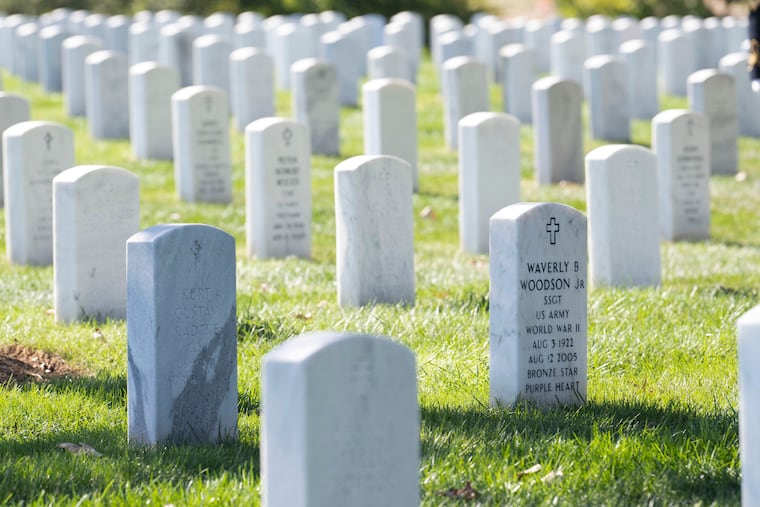Delayed honors for African American war heroes underscore Black history’s importance
The heroism of West Philly native Waverly Woodson, who was honored with a street renaming Friday, will be a revelation to most. Hopefully, other stories of previously unknown Black heroes will follow.

On Friday, Philadelphia honored Waverly B. Woodson Jr. — an Overbrook High School and Lincoln University graduate — by adding his name to a street sign near his boyhood home in the Carroll Park section of West Philadelphia.
The heroism of Woodson, a veteran of World War II, will be a revelation to most. African Americans weren’t depicted in war newsreels, nor were they seen in movies about D-Day such as The Longest Day and Saving Private Ryan. However, about 2,000 Black troops landed on Omaha and Utah Beaches.
As an amateur historian, I first learned about Woodson’s bravery in 1997, when the Army published The Exclusion of Black Soldiers from the Medal of Honor in World War II. That book highlighted the bravery of multiple individuals whose actions above and beyond the call of duty were “overlooked” in the awarding of our nation’s highest military award for bravery.
That omission was corrected in 1997, when seven soldiers were awarded the Medal of Honor. Unfortunately, most of Woodson’s military records had been destroyed in a massive 1973 fire (which coincidentally occurred on July 12). Woodson didn’t receive it.
It’s sad America needs to look to Germany to learn how to reconcile the present with history. From 1933 through 1945, Nazi Germany murdered over a third of the world’s Jews, destroyed thousands of synagogues and cemeteries, as well as Jewish schools and community buildings. Immediately after World War II ended, Germany coddled known Nazi war criminals and did little to acknowledge its sins.
However, over the last few decades, Holocaust education has become mandatory in German schools. Today, Germany has hundreds of historical markers and monuments recalling the official persecution of its Jews. It has rebuilt synagogues that were destroyed. It has installed over 100,000 Stolpersteine brass plaques permanently affixed to the pavement in front of buildings where Jews lived before they were murdered during the Nazi era.
Descendants of the survivors of the Middle Passage, which killed substantially over a million Africans on their horrific journey to the Americas, have suffered from slavery, debt peonage, sharecropping, lynching, state-sanctioned pogroms, redlining, segregation, discrimination, and police brutality. However, until recently, American schools have been reluctant to teach all this shameful history.
More than two decades ago, attorney Michael Coard began his campaign to incorporate historical references to the legacy of slavery at Independence Mall. Thanks to his efforts, the stories of how slaveholders Martha and George Washington kept their “property” a stone’s throw from the Cradle of Liberty are included at the President’s House Site, which is now a must-see for every school student and tourist.
Before 1990, the Pennsylvania Historical and Museum Commission had erected only two of its distinctive blue-and-gold historical markers recognizing African American individuals, institutions, or events in Black history. Charles L. Blockson, the noted scholar of Black history, dedicated the next 30 years of his life to getting the commission to erect over 50 African American-themed markers.
Today, there are efforts to limit teaching Black history and acknowledging that America has had a racist legacy.
Florida Gov. Ron DeSantis recently proclaimed that slaves benefited from slavery.
During the race for the Republican presidential nomination, former South Carolina Gov. Nikki Haley didn’t mention slavery when she was first asked about the cause of the Civil War.
African Americans weren’t depicted in World War II newsreels, nor were they seen in movies about D-Day.
Former Education Secretary Betsy DeVos stated that historically Black colleges and universities were established to support school choice, conveniently ignoring that many predominantly white institutions barred African American students.
Permanently acknowledging Woodson’s bravery brings his story to the fore. Hopefully, other stories of previously unknown African American heroes will follow.
The study of African American participation in World War II shouldn’t be limited to Dorie Miller and the Tuskegee Airmen. Over one million Black men, 6,500 Black members of the Women’s Army Corps, and 500 Black nurses served in North Africa, Liberia, Italy, Western Europe, the United Kingdom, Australia, Guadalcanal, Guam, Saipan, Iwo Jima, India, China, Hawaii, Alaska, and in every state.
The challenges these brave soldiers faced as they were subjected to segregation and discrimination in the military — while being expected to fight fascism abroad — became the crucible that forged in them a postwar spirit that forever changed America to truly being a country “with liberty and justice for all.” Their stories must be told.
Paul L. Newman is an amateur historian of African American history. He has written a miniseries docudrama on the African American civil rights movement of the first half of the 20th century.